Lawn mower maintenance & support
Helpful Tips
Cut Quality Concerns / Avoiding Stray Grass Strands PDF
Most issues with cut quality can be resolved by following the advice in Honda's helpful "Mowing a Great Looking Lawn".
Why Do Lawn Mower Crankshafts Bend? PDF
When considering why a lawn mower crankshaft bends, it's helpful to understand just how much energy exists in the rotating blades. A 21-inch Honda lawn mower blade tip moves at nearly 200 miles an hour!
Avoiding Fuel Related Problems
Following these tips will help you to avoid most fuel related problems.
How to Charge the Battery PDF
Instructions for charging the battery on HRR216K9VLA, HRX217K4VLA and HZA, and HRX217K5HZA mowers.
Support Videos
View all support videos here
Frequently Asked Questions
This is because the flywheel brake on the mower is engaged until you depress the flywheel brake lever (top lever) on the handlebars. Depressing this lever while pulling up on the handles will allow you to easily move the handles up.
American Honda's Distributor's Limited Warranty coverage starts from the date of the first retail purchase.
American Honda only manufactures new lawn mowers; we do not refurbish products for resale.Since Honda is not involved with the refurbishing, we have no knowledge of what work has been done to refurbished units, nor do we know the reason why they were returned to Home Depot. You would need to contact the store where the product was purchased for more information.
Refurbished mowers are sold "as-is", so any damaged or missing parts are the responsibility of the buyer or retailer, not American Honda.
Your lawn mower engine is not factory-equipped with a spark arrester. In some areas, it is illegal to operate an engine without a spark arrester. Check local laws and regulations. An optional USDA (United States Department of Agriculture) approved spark arrester is available from an authorized Honda servicing dealer.
Click here to view a list of optional spark arresters you can purchase from an authorized Honda dealer. Specific page for spark arrester kits is 2-9. PDF
Click here to find an authorized servicing Honda lawn mower dealer in your area.
(Applies to the HRB216, HRB217, HRR216, HRS216, HRT216, HRX217, and HRZ216 models
only) The spark arrester must be serviced every 100 hours to keep it functioning
as designed.
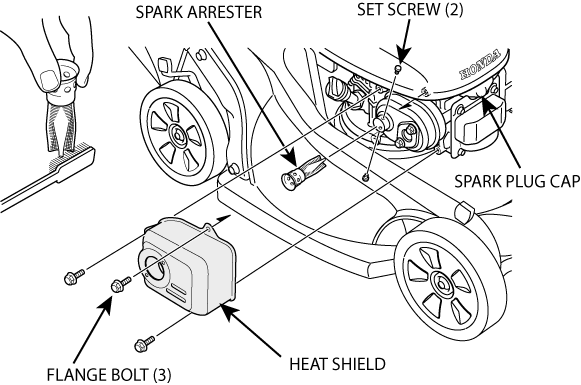
- Allow the engine to cool, and disconnect the spark plug cap to prevent accidental starting.
- Remove the three flange bolts and the heat shield.
- Remove the two set screws and the spark arrester from the muffler.
- Check for carbon deposits on the spark arrester and the exhaust port.
- Brush carbon deposits away. Be careful to avoid damaging the spark arrester screen.
- Installation is the reverse of removal. Tighten all hardware securely.
- Reconnect the spark plug cap.
(Applies to the HRX217HMA, HRX217HXA, HRX217HYA, HRX217HZA models only.)
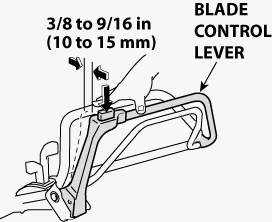
- Push and hold the yellow button down on the blade control lever and measure the free play at the top of the lever. Free play should be 3/8 to 9/16 in (10 to 15 mm). If adjustment is necessary:
-
Loosen the lock nuts with a 10 mm wrench, and move the adjuster up or down as required.
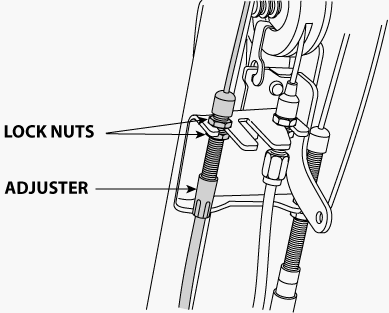
- Tighten the lock nuts and recheck the free play.
- Start the engine outdoors.
- Move the throttle to FAST.
- Operate the blade control lever. The blades should engage when you push the lever forward, and the blades should stop quickly when the lever is released. If the blades do not start or stop as they should with the correct cable adjustment, take the mower to an authorized Honda servicing dealer for repair.
(Applies to the HRX217HMA, HRX217HXA, HRX217HYA, HRX217HZA models only.)
-
With the engine stopped, position the control cable bands as shown.

- Pull the shift lever all the way back to the neutral position.
- Start the engine and move the throttle lever to the FAST position.
-
Engage the drive clutch lever and confirm the following:
- Mower does not self-propel.
- Mower begins to self-propel or creeps very slowly forward when the shift lever is moved one notch forward.
-
If adjustment is required, loosen the top and bottom drive clutch cable lock nuts
with a 10 mm wrench.
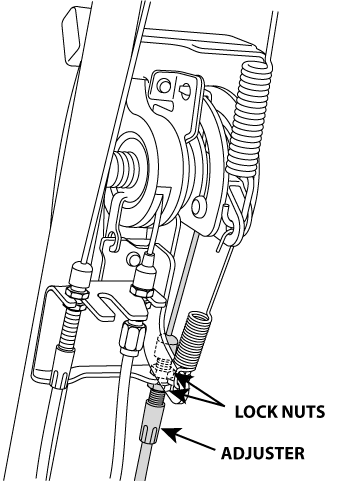
- Move the adjuster up or down, as required, until the mower operates as outlined in step 4.
- Tighten the lock nuts.
- If the mower will not operate correctly, take the mower to an authorized Honda servicing dealer.
-
Loosen the Smart Drive clutch cable LOCK NUT.
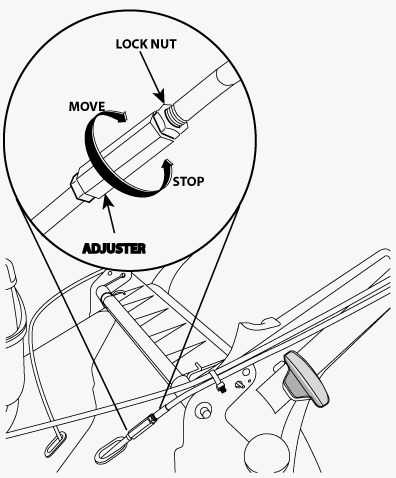
- Start the engine.
- Without engaging the Smart Drive grip, turn the clutch cable ADJUSTER in the MOVE direction until the lawn mower just begins to move forward.
- Turn the clutch cable ADJUSTER 1 to 2 turns in the STOP direction.
- Tighten the clutch cable LOCK NUT.
- Check the operation of the Smart Drive system.
Cable Check
-
With the engine off, use the multi-position adjuster to set the Smart Drive control in its lowest position.

-
With the engine off, loosen the adjuster jam nut.
- Without pushing the Smart Drive control, pull the lawn mower backwards to check wheel resistance.
- If no wheel resistance exists, mark the adjuster and TIGHTEN the adjuster one turn at a time until the wheels lock-up when pulling rearward.
- Turn the adjuster in the LOOSEN direction 8 complete revolutions (for K8 and later; MZCG-8400001 and later). For K5 through K7, do 4 complete revolutions.
- Tighten the jam nut to lock the adjuster in place.
Cable Check
-
With the engine off, use the multi-position adjuster to set the Smart Drive control in its lowest position.

- Gradually push the Smart Drive control down while pulling the lawn mower backwards. The rear wheels should lock up before the Smart Drive paddles are straight up-and-down. If they don't, perform the cable adjustment below.
-
With the engine off, loosen the jam nut one revolution.
- Without pushing the Smart Drive control, pull the lawn mower backwards to check wheel resistance.
- If no wheel resistance exists, mark the adjuster and TIGHTEN the adjuster one turn at a time until the wheels lock-up when pulling rearward.
- Turn the adjuster in the LOOSEN direction 4 complete revolutions.
- Tighten the jam nut to lock the adjuster in place.
Throttle cable adjustment is necessary if the throttle lever does not operate the choke properly.
-
Move the throttle lever to the FAST position.
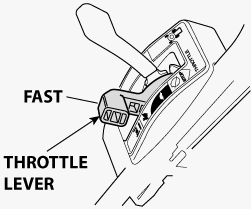
-
Remove the air cleaner cover.
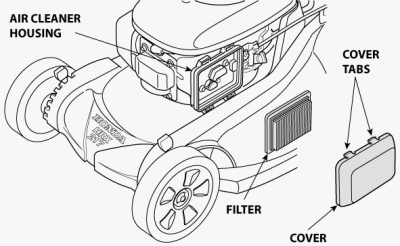
-
Use a feeler gauge and measure the clearance between the control choke arm and the
control lever. The clearance should be 0 to 0.040 in (0 to 1 mm).
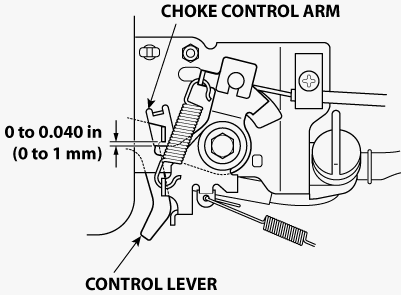
-
To adjust the clearance, loosen the lock nuts with a 10 mm wrench.
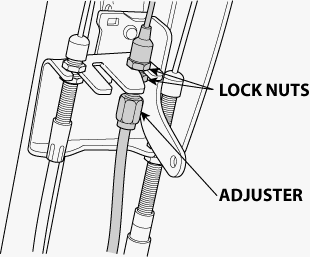
- Move the adjuster up or down as required to obtain the proper clearance.
- Tighten the lock nuts.
- Check the engine speed with a tachometer.
-
Move the throttle to the FAST position.

- With the engine off, loosen the locking clamp screw holding the cable.
- At the control plate, pull the cable backward slowly moving lever A and B.
-
4. When lever A stops moving, hold the cable in that position. DO NOT PULL
FARTHER.
Lever B can still move if you continue pulling hard enough. - Tighten the locking clamp screw.
- Start the engine and let it warm up.
-
Engage the Roto-Stop®, and then check the engine speed with the throttle set to the FAST position.
Maximum governed speed 2,950 ~ 3,100 rpm -
If the engine speed is not within specification, bend the governor spring arm very slightly as needed:
- Left increases spring tension and engine speed.
- Right decreases spring tension and engine speed.
Most grasses should be mowed when they have grown 1/2 to 1 inch above their recommended height. More frequent mowing is required for mulching than for bagging. For best mulching results, you may need to mow the lawn twice a week during the growing season.
If you look closely, you'll see that most grass has stems and leaves. If you cut
off the leaves, you'll scalp the lawn. Let the grass recover between mowings. Your
mower will work better, and your lawn will look better.


If your grass gets too tall, cut it once at the highest cutting height setting,
then mow again in 2 or 3 days. Don't take off more than one third of total grass
height in any one mowing, or brown patches may develop. Consult a local nursery
or lawn and garden center for cutting height recommendations and advice about specific
types of grasses and growing conditions in your area. Cutting height adjustment
is explained in the owner's manual.
A sharp blade cuts cleanly. A dull blade tears the grass, leaving shredded ends that turn brown. When your blade doesn't cut cleanly anymore, have it sharpened or replaced.
If the ground is too dry, mowing will stir up a lot of dust. Besides being unpleasant to work in, too much dust will clog the air filter. If dust is a problem, water your lawn the day before mowing. Mow when the grass is dry to your touch but the soil is still moist. Wet grass is slippery and can make you lose your footing. Also, wet grass clippings will clog the mower deck and collect in clumps on the lawn. Always wait for wet grass to dry before mowing.
Before clearing a clogged mower deck, stop the engine and turn the fuel valve to the OFF position. Disconnect the spark plug cap and tilt the mower so the air cleaner side is up. Clear a clogged deck with a stick, not your hands.
The blade must spin very fast to cut properly. Always use the FAST throttle setting to keep the engine running at maximum rpm. If engine speed drops, it could mean the engine is being overloaded by the blade trying to cut too much grass. Mow a narrower swath, mow at a slower pace, raise the cutting height, or move the Clip Director® knob (HRX217 only) toward the BAG position.
For an even lawn finish, overlap each mowing swath by a few inches. If the grass
is very tall or thick, use more overlap and a narrower mowing swath.
Your Honda mower will work most efficiently if you use the following mowing patterns
as much as possible. Mower deck and equipment design and the direction in which
the blade rotates cause these mowing patterns to give the best results.
Mulching
Use a counterclockwise mowing pattern when the mulching plug is inserted or the Clip Director® knob is in the full MULCH position. If the lawn has an irregular shape or many obstacles, divide it into sections where you can use counterclockwise mowing patterns.
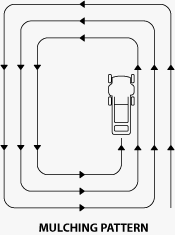
Bagging
Use a clockwise mowing pattern. This will give the best bagging performance, leaving the least amount of clippings on the lawn.
Rear-Discharge Mowing
Remove the grass bag and close the discharge guard. Remove the mulching plug or adjust the Clip Director knob to the desired setting and begin mowing in a clockwise mowing pattern. If the lawn has an irregular shape, or many obstacles, divide it into sections.
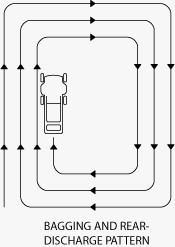
Your mower can be used to pick up fallen leaves for disposal. If using the mower to bag large amounts of fallen leaves and not for mowing, set the cutting height adjustment levers so the front of the mower deck is one or two settings higher than the rear.
If you want to mulch fallen leaves into your lawn, don't let the leaf cover get too deep before you begin. For best results, start mulching while grass still shows through the leaf cover. In places where fallen leaves completely cover the grass, remove the leaves by raking or use the grass bag so your mower can pick them up for disposal. Insert the mulching plug or position the Clip Director® knob in the MULCH position.
To bag leaves with the HRX217 mower, position the Clip Director knob in the #9 position (not quite full mulching) to start. This setting will allow the leaves to be recirculated and recut until the particles are small enough to pass though the sliding door opening and into the grass bag. Depending on the size, type, and water content of the leaves, it may be necessary to open the Clip Director to allow for best bagging results. Using the Clip Director correctly will allow better grass bag filling, resulting in less grass bag emptying. Be sure there are no obstacles, including rocks, hidden under the leaves.
To bag leaves with rear discharge mowers, install the optional leaf shredder in the discharge opening. The leaf shredder helps to chop up the leaves to better pack the grass bag so it won't have to be emptied as often. Be sure there are no obstacles, including rocks, hidden under the leaves.
Click here PDF for
a list of available leaf shredders for Honda lawn mowers. Specific page for leaf
shredders is 1-5.
Click here to find an authorized servicing Honda lawn mower
dealer in your area.
Support videos are available for the HRR216 and HRX217 series lawn mowers. Click here to view available videos.
Owners Manuals
Shop Manuals and Service Support Materials
- Parts Catalogs
- Service/repair manuals
- Carburetor Troubleshooting Manual
- Binders
- And much more!
These items are available to purchase from Honda Power Equipment's Company Store
Honda Power Equipment Parts Catalogs
Paper parts catalogs with details of every “nut and bolt” may be purchased from Honda Power Equipment's Company Store
Honda also has online parts listings for most models: peparts.honda.com








